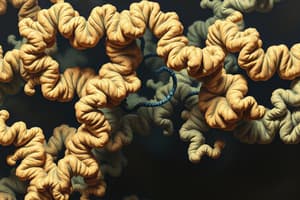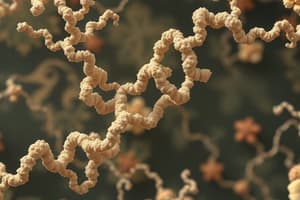Podcast
Questions and Answers
What is the primary characteristic of tertiary protein structure?
What is the primary characteristic of tertiary protein structure?
- It is solely defined by beta pleated sheets.
- It results from interactions between widely separated amino acids. (correct)
- It involves multiple peptide chains.
- It exists only in membrane proteins.
Which of the following roles does myoglobin serve in muscle tissue?
Which of the following roles does myoglobin serve in muscle tissue?
- It provides structural support to muscle fibers.
- It serves as an intracellular storage site for oxygen. (correct)
- It functions as an enzymatic catalyst.
- It acts as a signaling molecule.
How does tertiary protein structure differ from secondary protein structure?
How does tertiary protein structure differ from secondary protein structure?
- Secondary structure is always a pleated sheet formation.
- Tertiary structure involves interactions between easily reached amino acids.
- Tertiary structure consists of alpha helices only.
- Tertiary structure represents the overall three-dimensional shape of a protein. (correct)
What is the term for a segment of a protein structure that does not conform to either alpha helices or beta pleated sheets?
What is the term for a segment of a protein structure that does not conform to either alpha helices or beta pleated sheets?
What primarily dictates the tertiary structure of a protein?
What primarily dictates the tertiary structure of a protein?
Why is an unstructured protein segment important in protein function?
Why is an unstructured protein segment important in protein function?
Which statement best describes the U-turn structure found in beta pleated sheets?
Which statement best describes the U-turn structure found in beta pleated sheets?
What defines the tertiary structure of a protein?
What defines the tertiary structure of a protein?
Which types of interactions contribute to the stability of tertiary structure?
Which types of interactions contribute to the stability of tertiary structure?
How do the forces contributing to tertiary structure compare to those in primary structure?
How do the forces contributing to tertiary structure compare to those in primary structure?
Which statement about tertiary structure is incorrect?
Which statement about tertiary structure is incorrect?
What is a characteristic feature of proteins with a well-defined tertiary structure?
What is a characteristic feature of proteins with a well-defined tertiary structure?
Which statement best describes the importance of tertiary structure in proteins?
Which statement best describes the importance of tertiary structure in proteins?
Which type of bond is the least significant in stabilizing the tertiary structure of proteins?
Which type of bond is the least significant in stabilizing the tertiary structure of proteins?
In which way can tertiary structure affect the biological activity of a protein?
In which way can tertiary structure affect the biological activity of a protein?
What characteristic defines the primary structure of a protein?
What characteristic defines the primary structure of a protein?
Which of the following best describes the secondary structure of a protein?
Which of the following best describes the secondary structure of a protein?
What feature is common to the alpha helix structure in proteins?
What feature is common to the alpha helix structure in proteins?
Which statement about insulin's primary structure is true?
Which statement about insulin's primary structure is true?
What type of bonding typically contributes to the stability of secondary protein structures?
What type of bonding typically contributes to the stability of secondary protein structures?
Flashcards are hidden until you start studying
Study Notes
Classification of Protein Structures
-
Quaternary Structure:
- Highest level of protein organization involving multiple peptide subunits.
- Commonly contains an even number of subunits: dimers (2 subunits) and tetramers (4 subunits).
- Stabilized by noncovalent interactions, similar to tertiary structure (electrostatic interactions, hydrogen bonds, hydrophobic interactions).
- Noncovalent interactions are weaker and more susceptible to disruption.
-
Primary Structure:
- Refers to the unique sequence of amino acids in a protein.
- Proteins have specific sequences determined by peptide bonds.
- Insulin has a primary structure of 51 amino acids and was the first protein to have its structure determined.
-
Secondary Structure:
- Regularly repeating arrangements of amino acids, primarily stabilized by hydrogen bonds.
- Alpha Helix:
- Coiled spring-like structure maintained by hydrogen bonds between every fourth amino acid.
- Right-handed spiral with R groups extending outward from the helix.
- Beta Pleated Sheet:
- Formed by hydrogen bonds between adjacent segments of a protein chain, either intrachain or interchain.
- Commonly characterized by a zigzag pattern; involves U-turn structures to align strands.
- Unstructured Protein Segments:
- Lack a defined structure (neither α helix nor β sheet).
- Crucial for flexibility in proteins, enabling interactions with various substances.
-
Tertiary Structure:
- Overall three-dimensional shape of a protein due to interactions among widely separated amino acids (R groups).
- Stabilized by disulfide bonds, electrostatic interactions, hydrogen bonds, and hydrophobic interactions.
- Myoglobin serves as an example, functioning primarily in muscle tissue for oxygen storage.
-
Protein Denaturation:
- Disruption or unfolding of the protein's three-dimensional structure without breaking peptide bonds.
- Affects the protein's functionality and can be caused by environmental changes (temperature, pH).
Studying That Suits You
Use AI to generate personalized quizzes and flashcards to suit your learning preferences.




